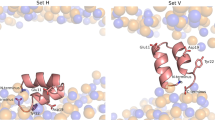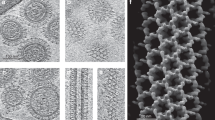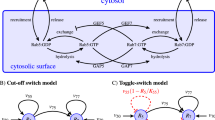Abstract
Hemagglutinin, the membrane fusion protein of influenza virus, is known to mediate a low-pH-dependent fusion reaction between the viral envelope and the limiting membrane of the endosomal cell compartment following cellular uptake of the virus particles by receptor-mediated endocytosis. Here we exploited this activity of hemagglutinin to achieve efficient gene delivery to cultured cells. Hemagglutinin was reconstituted in the presence of the monocationic lipid dioleoyldimethylammonium chloride (DODAC) to permit plasmid binding to the virosome surface. Virosomes with 30 mol% DODAC exhibited a distinct binding capacity for plasmid without causing aggregation. The virosome fusion activity was not affected by the cationic lipid DODAC as demonstrated by low-pH-dependent lipid mixing with erythrocyte ghosts. Efficient cell transfection of BHK-21 cells was observed with virosomes containing 30 mol% DODAC and plasmid encoding for β-galactosidase (pCMV β-gal) associated to their surface. The transfection activity observed was dependent on the functional activity of hemagglutinin. Contrary to DNA/cationic lipid complexes the transfection was not dependent on the cationic lipid to DNA charge ratio. Importantly, transfection of BHK-21 cells with pCMV β-gal by DODAC-containing virosomes did not show any significant signs of cytotoxicity that is commonly observed with DNA/cationic lipid complexes. Together with the high levels of expression of the transgene this highlights the potential of DODAC-containing virosomes as a novel approach in nonviral gene transfer.
This is a preview of subscription content, access via your institution
Access options
Subscribe to this journal
Receive 6 print issues and online access
$259.00 per year
only $43.17 per issue
Buy this article
- Purchase on SpringerLink
- Instant access to full article PDF
Prices may be subject to local taxes which are calculated during checkout








Similar content being viewed by others
References
Cristiano RJ, Roth JA . Molecular conjugates: a targeted gene delivery vector for molecular medicine J Mol Med 1995 73: 479–486.
Gao X, Huang L . Cationic liposome-mediated gene transfer Gene Therapy 1995 2: 710–722
Remy JS et al. Targeted gene transfer into hepatoma cells with lipopolyamine-condensed DNA particles presenting galactose ligands: a stage toward artificial viruses Proc Natl Acad Sci USA 1995 92: 1744–1748
Cooper MJ . Noninfectious gene transfer and expression systems for cancer gene therapy Semin Oncol 1996 23: 172–187
Felgner PL et al. Lipofection: a highly efficient, lipid-mediated DNA-transfection procedure Proc Natl Acad Sci USA 1987 84: 7413–7417.
Zhou X, Huang L . DNA transfection mediated by cationic liposomes containing lipopolylysine: characterization and mechanism of action Biochim Biophys Acta 1994 1189: 195–203
Wrobel I, Collins D . Fusion of cationic liposomes with mammalian cells occurs after endocytosis Biochim Biophys Acta 1995 1235: 296–304
Friend DS, Papahadjopoulos D, Debs RJ . Endocytosis and intracellular processing accompanying transfection mediated by cationic liposomes Biochim Biophys Acta 1996 1278: 41–50
Wagner E, Curiel D, Cotten M . Delivery of drugs, proteins and genes into cells using transferrin as a ligand for receptor-mediated endocytosis Adv Drug Del Rev 1994 14: 113–135
Gottschalk S et al. A novel DNA–peptide complex for efficient gene transfer and expression in mammalian cells Gene Therapy 1996 3: 448–457
Wagner E et al. Influenza virus hemagglutinin HA-2 N-terminal fusigenic peptides augment gene transfer by transferrin-polylysine–DNA complexes: toward a synthetic virus-like gene-transfer vehicle Proc Natl Acad Sci USA 1992 89: 7934–7938
Kamata H, Yagisawa H, Takahashi S, Hirata H . Amphiphilic peptides enhance the efficiency of liposome-mediated DNA transfection Nucl Acids Res 1994 22: 536–537
Plank C et al. The influence of endosome-disruptive peptides on gene transfer using synthetic virus-like gene transfer systems J Biol Chem 1994 269: 12918–12924
Wilschut J, Bron R . The influenza virus hemagglutinin: membrane fusion activity in intact virons and reconstituted virosomes. In: Bentz J (ed) . Viral Fusion Mechanisms CRC Press: Boca Raton, FL 1993 133–160
Stegmann T . Membrane fusion Curr Biol 1994 4: 551–554
Hughson FM . Molecular mechanisms of protein-mediated membrane fusion Curr Opin Struct Biol 1995 5: 507–513
Stegmann T et al. Functional reconstitution of influenza virus envelopes EMBO J 1987 6: 2651–2659
Bron R et al. Preparation, properties, and applications of reconstituted influenza virus envelopes (virosomes) Meth Enzymol 1993 220: 313–331
Schoen P, Bron R, Wilschut J . Delivery of foreign substances to cells mediated by fusion-active reconstituted influenza virus envelopes J Liposome Res 1993 3: 767–792
Bron R, Ortiz A, Wilschut J . Cellular cytoplasmic delivery of a polypeptide toxin by reconstituted influenza virus envelopes (virosomes) Biochemistry 1994 33: 9110–9117
Stegmann T et al. Evaluation of viral membrane fusion assays. Comparison of the octadecylrhodamine dequenching assay with the pyrene excimer assay Biochemistry 1993 32: 11330–11337
Ohkuma S, Poole B . Fluorescence probe measurement of the intralysosomal pH in living cells and the perturbation of pH by various agents Proc Natl Acad Sci USA 1978 75: 3327–3331
Stegmann T, Hoekstra D, Scherphof G, Wilschut J . Fusion activity of influenza virus. A comparison between biological and artificial target membrane vesicles J Biol Chem 1986 261: 10966–10969
Gershon H, Ghirlando R, Guttman SB, Minsky A . Mode of formation and structural features of DNA–cationic liposome complexes used for transfection Biochemistry 1993 32: 7143–7151
Xu Y, Szoka Jr FC . Mechanism of DNA release from cationic liposome/DNA complexes used in cell transfection Biochemistry 1996 35: 5616–5623
Farhood H, Serbina N, Huang L . The role of dioleoylphosphatidylethanolamine in cationic liposome mediated gene transfer Biochim Biophys Acta 1995 1235: 289–295
Litzinger DC et al. Fate of cationic liposomes and their complex with oligonucleotide in vivo Biochim Biophys Acta 1996 1281: 139–149.
Liu F, Yang J, Huang L, Liu D . New cationic lipid formulations for gene transfer Pharm Res 1996 13: 1856–1860
Hagstrom JE et al. Complexes of non-cationic liposomes and histone H1 mediate efficient transfection of DNA without encapsulation Biochim Biophys Acta 1996 1284: 47–55
Zabner J et al. Cellular and molecular barriers to gene transfer by a cationic lipid J Biol Chem 1995 270: 18997–19007
Shangguan T, Alford D, Bentz J . Influenza-virus-liposome lipid mixing is leaky and largely insensitive to the material properties of the target membrane Biochemistry 1996 35: 4956–4965
Saeki Y et al. Development and characterization of cationic liposomes conjugated with HVJ (Sendai virus): reciprocal effect of cationic lipid for in vitro and in vivo gene transfer Hum Gene Ther 1997 8: 2133–2144
Birnboim HC, Doly J . A rapid alkaline extraction procedure for screening recombinant plasmid DNA Nucleic Acids Res 1979 7: 1513–1523
Ames BN . Assay of inorganic phosphate, total phosphate and phosphatases Meth Enzymol 1966 8: 115–118
Böttcher CJF, van Gent CM, Pries CA . Rapid and sensitive submicro phosphorus determination Anal Chim Acta 1961 24: 203–204.
Steck TL, Kant JA . Preparation of impermeable ghosts and inside-out vesicles from human erythrocyte membranes Meth Enzymol 1974 31: 172–180
Bligh EG, Dyer WJ . A rapid method of total lipid extraction and purification Can J Biochem Physiol 1959 37: 911–917
Author information
Authors and Affiliations
Rights and permissions
About this article
Cite this article
Schoen, P., Chonn, A., Cullis, P. et al. Gene transfer mediated by fusion protein hemagglutinin reconstituted in cationic lipid vesicles. Gene Ther 6, 823–832 (1999). https://doi.org/10.1038/sj.gt.3300919
Received:
Accepted:
Published:
Issue date:
DOI: https://doi.org/10.1038/sj.gt.3300919
Keywords
This article is cited by
-
A novel chimeric influenza virosome containing Vesicular stomatitis G protein as a more efficient gene delivery system
Biotechnology Letters (2016)
-
Nanocarrier Mediated Cytosolic Delivery of Drug, DNA and Proteins
Proceedings of the National Academy of Sciences, India Section B: Biological Sciences (2012)
-
Pseudovirions as Vehicles for the Delivery of siRNA
Pharmaceutical Research (2010)
-
The concept of molecular machinery is useful for design of stimuli-responsive gene delivery systems in the mammalian cell
Journal of Inclusion Phenomena and Macrocyclic Chemistry (2007)
-
Preparation of cationic liposome containing a novel water-soluble detergent and its application to gene deliveryIn vitro
Macromolecular Research (2007)



